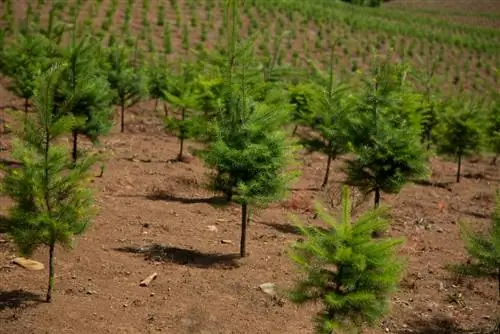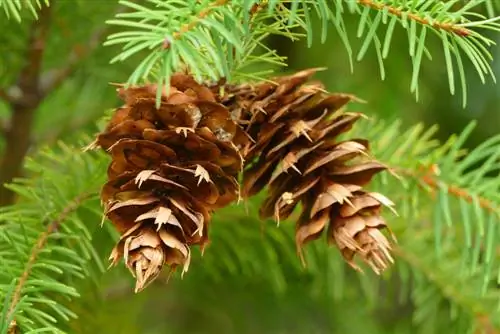- Author admin [email protected].
- Public 2023-12-16 16:46.
- Last modified 2025-01-23 11:21.
The Douglas fir grows quickly and reaches an impressive size. At the same time, a root system must develop in the earth that is suitable for this tree, supplies it with water and nutrients and at the same time gives it a firm footing. Let's take a closer look at the root.

What is the root system of a Douglas fir like?
The roots of a Douglas fir consist of deep taproots and shallow roots that form a cardiac root system. When young, deep roots develop first, followed later by shallow roots. The roots spread to a depth of approx. 1.5 m and adapt flexibly to site conditions.
The Douglas fir is a so-called heartroot
Plants of all kinds are divided into shallow-rooted and deep-rooted, depending on how their roots spread in the soil. The larch does not belong in either category alone because it has both deep and shallow roots. This combination of different roots is also known as the heart root system.
The heart gives its name because the cross-section of the root system, viewed from the side, resembles a heart shape.
The development of roots
When young, Douglas fir forms deep taproots that branch out on all sides. This is also necessary because this type of tree grows quickly and therefore needs good anchoring. This means that even a strong wind cannot cause the Douglas fir to collapse.
Shallow roots follow later, so that the entire soil is covered. The deep roots also make this tree less sensitive to drought, as it can still easily supply itself with water from the depths.
The root system of a Douglas fir spreads out to a depth of approx. 1.5 m.
Flexible adaptation to location conditions
A tree is a living being that does not form its roots according to a rigid plan. It reacts to some environmental factors and adapts to them as best it can.
- permeable soil makes deep roots possible
- nutrient-rich surface promotes shallow roots
Attention: sensitive roots
Young Douglas firs have sensitive roots that can dry out quickly if left unprotected. Therefore, if possible, do not buy bare-root trees to minimize the risk. Douglas fir has difficulty compensating for root damage.
Root-suitable location
The older a Douglas fir gets, the larger and stronger its roots develop. At the beginning, this circumstance will neither be visible nor cause any problems. However, if the Douglas fir is placed in an unsuitable location, its roots can soon become a threat.
- Tree should not be too close to buildings
- pay attention to nearby underground pipes
The power that a root can develop cannot be underestimated. She will emerge victorious from a duel with a line and that can be expensive.






